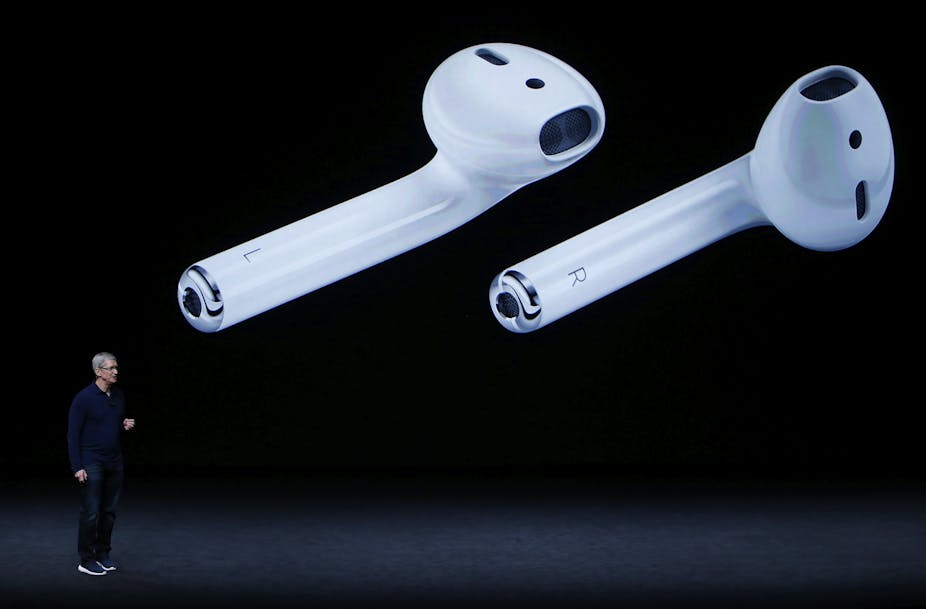It’s been a tough month for mobile phone manufacturers: Samsung has recalled its Galaxy Note 7 due to exploding batteries, the European Commission has handed Apple a €13 billion fine for its tax practices in Ireland, and Google has withdrawn from the modular phone project which would have allowed consumers to switch out components as and when they wanted.
So this year’s September Keynote product launch should offer Apple an easy opportunity to impress the market with announcements of the new iPhone 7 and iPhone 7 Plus, a slight upgrade to the watch, now called Series 2, and various software updates. But notable by its absence was any announcement related to the product that made Apple’s name: the Mac.
New but familiar, the iPhone 7
Apple tends to redesign the iPhone bi-annually, with alternate years offering speed bumps and minor features. This year brings major revisions, with a new design, a dual camera system that offers better zoom, higher resolution images, and the controversial removal of the universal standard audio jack.
The diameter of the audio jack limited designers’ ability to shrink the phone further, so its days were numbered. Instead headphones will be wireless using bluetooth, or plug into the Lightning port. Apple has of course released its own wireless Airpod headphones (RRP: US$159/£120), or those with expensive headphones can buy an adaptor to keep using them. Dropping such a well supported standard is a typically bold Apple move, but other manufacturers have already tried it – the Motorola Moto Z for example – with limited success.
The iPhone’s system software is also boosted to iOS 10, which makes more of the system software accessible to developers – for example Siri will be available in third-party apps. While improvements will only be felt once apps start to integrate these features, the messages and messaging experience will be improved, an attempt to counter the success of Whatsapp and Facebook messenger. This update will arrive for older devices on September 13.

Watch Series 2, now waterproof
The Watch Series 2 follows the same cycle with major revisions every other year, bringing on this occasion a minor upgrade of faster components, a better screen, waterproofing and the new watchOS within the same shell. Significant architectural changes to watchOS should speed up applications, and brings changes to several design metaphors. Adding GPS to the watch allows a degree of decoupling from the iPhone, but the iPhone still has to be in range for much of the Watch’s functions. Despite it’s sluggish sales, this is still the device to beat. Particularly if you are addicted to Pokemon Go (which now runs on the the Watch).
Does anyone still care about the Mac?
For many years, there has been a vocal minority arguing that every Apple Keynote is the last opportunity for the company to demonstrate that it can still out-innovate the competition and to counter the prevailing wisdom that Apple has abandoned its professional users for consumer-focused devices. For the first time time in a long while, Apple’s computer sales recently dropped and even iPhone sales fell.
To some extent this is true: the line of Mac computers that made the company’s fortune from the 1980s onwards has been moribund over the last two or three years. Some Mac products have dropped off review site and magazines’ recommended lists. So it’s surprising that there were no updates to any of the Mac products. Most of the desktops and laptops now contain very old components, leaving creative professionals who are the Mac-using Apple stalwarts with outdated and ageing equipment. Someone at Apple needs reminding that the developers who create apps for the iPhone use Mac computers.
So, while the iPhone 7 will be desirable for those using substantially older iPhones, upgrading from the previous generation iPhone 6 or 6s is harder to justify. There probably isn’t enough to replicate the massive sales surge when they first introduced the larger iPhone 6, but the slide towards online services allows Apple to transition towards making more money from storage and services – which encroaches on Google’s income stream. Is there enough here for Android users to justify a switch? Probably not. And while the new Apple Watch isn’t sufficiently different from last year’s model to massively increase sales, it may appeal to those who exercise regularly or for whom waterproofing is helpful.
But changes to the pro-computer line are needed desperately. Apple needs to bring back more regular updates to ensure it doesn’t begin to lose its heartlands – those who were Apple buyers well before the iPhone took the world by storm. At the same time, its easy to see the root of Apple’s laser-like focus on its phone: other mobile manufacturers make very little money from their phones, while each iPhone is sold at a 40% profit, adding to the huge cash mountain upon which Apple sits.

